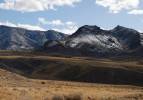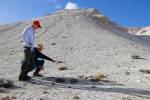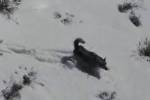Trump administration order may put sage grouse on endangered list
WASHINGTON — A Trump administration directive eliminating industry and developer payments for habitat protection in exchange for use of public lands has officials in Western states scrambling for answers and worried about economic consequences if the threatened greater sage grouse is listed as endangered.
The Bureau of Land Management issued the directive in July to discontinue “compensatory mitigation,” a tool that provided funds to protect wildlife habitat.
Governors in Western states agreed in 2015 to a plan that used compensatory mitigation to offset environmental damage, which kept the Obama administration from listing the sage grouse as endangered.
The agreement allowed public land use by ranchers and oil, gas and mining interests, which provide local jobs.
Interior Secretary Ryan Zinke has been critical of compensatory mitigation, and the BLM directive claimed the practice could not be legally enforced. The new directive does allow for voluntary participation.
But without dedicated funds to protect habitat, and with the loss of state control over public land use, the federal directive poses new problems and concerns about the long-term economic impact on communities.
Sen. Catherine Cortez Masto, D-Nev., said the sage grouse agreements reached under the Obama administration “were the result of years of careful negotiation between the federal government and Western state governors, with input from conservationists, industries and other stakeholders.
“This reckless directive from the Trump administration will disrupt the delicate balance struck in 2015, jeopardizing the sage grouse population as well as Nevada’s economic development,” said Cortez Masto, a former Nevada attorney general.
Governors voice opposition
Cortez Masto wrote to Zinke and Agriculture Secretary Sonny Perdue on July 31 to urge the administration not to make changes that would affect the 2015 plan.
Governors in Colorado and Wyoming also have voiced opposition to the BLM directive, while Nevada Gov. Brian Sandoval, a Republican, is seeking clarification from BLM officials on the change in policy.
Sandoval, through his Carson City policy director, told the BLM that Nevada has worked toward conservation of habitat to keep the sage grouse from being listed under the Endangered Species Act, and restoration of sagebrush ecosystems is crucial to prevent a future listing.
The governor’s office told BLM in an Aug. 2 letter that compensatory mitigation is often used to achieve those goals.
Energy industry groups and associations representing farmers and ranchers are urging the Trump administration to roll back public-land-use restrictions that they claim are impeding economic development that would help states and communities.
But those groups, state governors and officials agree that listing the greater sage grouse as endangered would cut off access entirely to critical habitat.
In Nevada, that amounts to roughly 20 million acres of public lands with threatened species that includes the Mojave Desert tortoise as well as the sage grouse.
The U.S. Fish and Wildlife Service cited habitat loss to energy exploration and livestock grazing as a reason for the sage grouse population dropping from 16 million birds to about 200,000 in recent decades.
2015 conservation plan
The 2015 conservation plan in Nevada was reached after negotiations among federal agencies, the state, conservation groups, industry officials, livestock growers, cattlemen and communities.
The result was the Compensation Credit System, which provided the means to allow development and ranching and protection of habitat. It was not ideal to all stakeholders but was a compromise that could be accepted by the various interests.
Other states constructed similar agreements to avoid an endangered species listing of the sage grouse.
“Watering down these plans is a one-way street to let sage grouse go extinct,” said Patrick Donnelly, Nevada director with the Center for Biological Diversity.
Donnelly said a lack of plans and the means to protect habitat for the sage grouse “will call into question the legitimacy not to list.”
With the survival of the bird in question, a lawsuit seeking an endangered species listing for the sage grouse could likely come from a conservation group as a last-ditch effort to save the bird, Donnelly said.
A spokeswoman for Sandoval said last month that such “a listing would not be good for Nevada or other Western states.”
In the 1970s, the listing of the snail darter as an endangered species led to the halt of a dam project by the Tennessee River Authority. And logging in the Northwest was stopped in the 1990s when scientists showed that the harvesting of timber threatened the spotted owl with extinction.
The Trump administration has proposed changes to the Endangered Species Act that would require federal agencies to consider the economic impact before a listing, a move environmental groups say would gut the 45-year-old law.
Contact Gary Martin at gmartin@reviewjournal.com or 202-662-7390. Follow @garymartindc on Twitter.
Related
Lawmakers strip sage grouse provision from defense bill
Forest Service plans to roll back sage grouse protections
Interior unveils plans to roll back sage grouse protections































